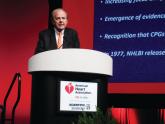Dr. Lawrence also reported that nearly 1,200 total health care organizations were participating in Target:BP as of his presentation, and that the 310 programs that reported 2016 data cared for roughly 12 million people, numbers that extrapolate to more than 45 million Americans cared for in all 1,200 organizations now participating in Target:BP. Among all 310 organizations reporting 2016 data, the average level of hypertension control (patients with BPs maintained at less than 140/90 mm Hg) was 66%, said Dr. Lawrence, chief of cardiology at Research Medical Center in Kansas City, Mo. The cited “gold” programs averaged 76% of their hypertensive patients treated to less than 140/90 mm Hg.
The second thread of Target:BP’s program is to supply participating organizations with training and practice tools aimed at improving hypertension diagnosis and management. The core element of the tools the program currently promotes is the MAP checklists, which stands for Measure accurately, Act rapidly, and Partner with patients, families, and communities (J Clin Hypertens. 2017 Jul;19[7]:684-94).
Target:BP’s focus on a recognition program for organizational success in BP management is very reminiscent of the Get With the Guidelines programs that the AHA previously launched for the management of various cardiovascular diseases such as ischemic stroke. Get With the Guidelines–Stroke, begun in the early 2000s, helped achieve recent success in improving the rates at which U.S. stroke patients receive timely intervention with tissue plasminogen activator, demonstrating the power a recognition program can have for improving patient care.
Target:BP moved quickly to embrace the new ACC/AHA guideline BP targets, posting a treatment target of less than 130/80 mm Hg on its website by December 2017, scant weeks after the guideline’s release in mid-November. But for the time being, Target:BP will continue to use the NQF BP quality metric as the basis for its recognition program, according to an AMA spokesperson for the program. “While the AHA and AMA will keep our joint recognition program in accordance with the NQF measure, we will simultaneously build resources, including an updated treatment algorithm, that align with the new blood pressure guideline,” according to an AMA statement.
